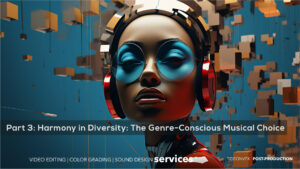Audio
Crafting an Unforgettable Experience: The Art of Music in Film Editing
Image Courtesy of Blackeyehub.com
Part 5: Crafting an Unforgettable Experience: The Art of Music in Film Editing
Welcome to the final chapter of our journey through the pivotal role of music in film editing. In this instalment, we’ll venture into the practicalities of music selection and integration, exploring how these choices, from licensing to collaboration, can elevate a film from good to unforgettable.
The Delicate Dance of Frames and Music
Film editing is an art that involves more than just cutting and joining footage. It’s about creating a rhythm, a heartbeat, that guides the viewer through the story. Music is a key partner in this dance, adding depth and dimension to the visual narrative. But how do we ensure this partnership is successful?
Licensing: Navigating the Legal Landscape
The first step is often the most daunting – securing the rights to use a particular piece of music. Licensing music can be a complex process, involving negotiations with rights holders and navigating the intricacies of copyright laws. An editor must consider not only the artistic fit but also the legal and financial aspects. Choosing royalty-free music or commissioning original compositions are viable alternatives when popular tracks are beyond budgetary constraints or licensing capabilities.
Collaborating with Composers
When the project calls for original music, working with composers becomes a pivotal part of post-production. This collaboration is a dance of its own, requiring clear communication of the film’s vision and the emotional beats that the music needs to hit. A good composer doesn’t just create a score; they breathe life into the editor’s rhythmic vision, ensuring that the music complements every scene’s tone and pacing.
The Editor’s Musical Toolbox
As editors, we must develop an ear for not just what sounds good, but what feels right. Understanding various musical genres and how they influence emotions and pacing is crucial. Sometimes, the best choice might be a lack of music, using silence to create impact. Other times, an unexpected genre or instrument choice can add a layer of depth to a scene.
The Final Cut: Where Music Meets Picture
In the end, the magic happens in the editing suite. Here, the chosen music is woven into the fabric of the film. This process requires a delicate balance – ensuring the music enhances without overpowering the visuals. It’s about finding those perfect moments where the music swells or recedes at just the right time to resonate with the audience.
Conclusion: A Symphony of Sight and Sound
The role of music in film editing is both an art and a science. It requires technical knowledge, a creative ear, and an intuitive sense of storytelling. As we close this series, remember that the right music can transform a series of scenes into an emotional journey, leaving a lasting impression on the audience. By mastering the dance of frames and music, we don’t just edit films; we craft unforgettable cinematic experiences.
Thank you for following this series. May your next project not only be seen, but also felt, as you master the art of bringing visuals and music together in harmony.
If you have just started reading this blog series, you may want to start at the beginning post: What is the function of film music?
If you have any questions, feel free to contact us.









